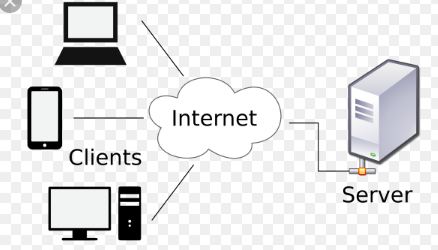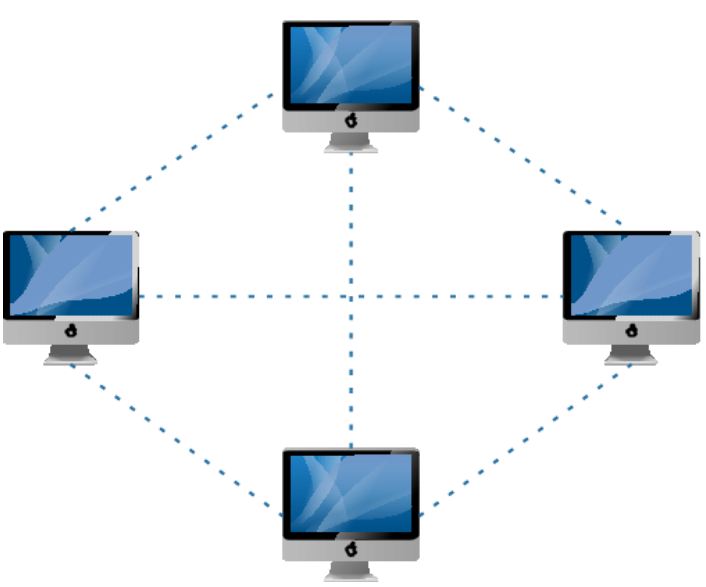Client-Server Network
A client server network is a specific type of online network comprised of a single central computer acting as a server that directs multiple other computers, which are referred to as the clients. By accessing the server, clients are then able to reach shared files and information saved on the serving computer. Examples of computer applications that use the client-server model are Email, network printing and the World Wide Web.
In a client-server model, whether a computer is a client, server or both, is determined by the nature of the application that requires the service functions. For example, a single computer can run web server and file server software at the same time to serve different data to clients making different kinds of request. Client software can also communicate with server software within the same computer.

What You Need To Know About Client-Server Network
- Client-Server Network focuses on information sharing. Though the server can share its resources with clients, clients do not share their resources such as computing power or hard drive space with the network.
- In Client-Server Network, centralized server is used to store the data. Centralized file storage makes it easier to back up and protect data.
- The client-server are expensive to implement. An additional computer is required to act as the server and because of the extra computing power a server requires, a high-performance machine is required.
- In Client-Server Network, Clients and server are differentiated, specific server and clients are present.
- Client-Server Network is more stable and scalable.
- In Client-Server Network, the client requests for service and server responds with a service
- The Client-server network is very much secure when compared the Peer-to-Peer Network. This is because the server can authenticate a client’s access to any part of the network.
- The Client-server arrangement does not experience performance problems in case the number of client increases. This is because the server does a lot of the heavy lifting and that the clients are not required to share their computing power.
- In Client-server Network, the clients depend on the server. Failure in the server will disrupt the functioning of all clients. Therefore, it is unreliable.
- In Client-server Network, multiple clients request for services from a server and therefore, the access time for a service is higher.
Peer To Peer Network (P2P Network)
A peer-to-peer network is a group of computers or computer systems which are connected to each other through internet. Files can be shared directly between systems on the network without the need of a central server. In other words, each computer on a peer-to-peer network becomes a file server as well as a client.
When a peer-to-peer network is established over the internet, a central server can be used to index files or a distributed network can be established where sharing of files is split between all the users in the network that are storing a given file. Files and folders can be configured to allow network users to copy them, but not alter them in their original location.
Peer-to-peer networks are quite common in small offices that do not require a dedicated file server. All client versions of Windows, Mac and Linux can function as nodes in a peer-to-peer network and allow their files to be shared.
Usually internet connection and a peer-to-peer network are the only things a computer requires to join a peer-to-peer network. Some of the common peer-to-peer software programs include: Kazaa, BearShare, Acquisition, Limewire and Morpheus.

What You Need To Know About Peer-To-Peer Network
- Peer-to-Peer Network focuses on connectivity. They are usually found in homes and small offices that don’t require centralized access to files or services.
- Peer-to-Peer Network, each peer has its own data. The server id decentralized.
- Peer-to-peer Network is less expensive to implement. Connecting an Ethernet cable between two laptops creates the most basic peer-to-peer network.
- In Peer-to-Peer Network, clients and server are not differentiated.
- Peer-to-Peer Network are less stable if number of peer is increased.
- In Peer-to-Peer Network, each and every node can make both request and respond for the services.
- The Peer-to-Peer is less secure when compared to Client-server Network and in fact it becomes more problematic as the number of clients increases.
- In case of large number of clients in a Peer-to-Peer Network, performance problems are highly likely to be experienced since all resources are shared.
- There are multiple service providing nodes in a Peer-to-Peer Network and therefore it is more reliable.
- In Peer-to-Peer Network, the service providing nodes are distributed, the service requesting node does need to wait long.
Difference Between Client-server And Peer-To-Peer Network In Tabular Form
| BASIS OF COMPARISON | CLIENT-SERVER NETWORK | PEER-TO-PEER NETWORK |
| Focus | Focuses on information sharing. | Focuses on connectivity. |
| Data | Centralized server is used to store the data. | Each peer has its own data. |
| Implementation | Less expensive to implement. | It is less expensive to implement. |
| Differentiation | Clients and server are differentiated, specific server and clients are present. | Clients and server are not differentiated. |
| Stability | Client-Server Network is more stable and scalable. | Peer-to-Peer Network are less stable if number of peer is increased. |
| Service | The client requests for service and server responds with a service | Each and every node can make both request and respond for the services. |
| Security | It is very much secure when compared the Peer-to-Peer Network. This is because the server can authenticate a client’s access to any part of the network. | It is less secure when compared to Client-server Network and in fact it becomes more problematic as the number of clients increases. |
| Performance | The Client-server arrangement does not experience performance problems in case the number of client increases. This is because the server does a lot of the heavy lifting and that the clients are not required to share their computing power. | In case of large number of clients in a Peer-to-Peer Network, performance problems are highly likely to be experienced since all resources are shared. |
| Reliability | It is less reliable. | It is more reliable. |
| Access Time For Service | Multiple clients request for services from a server and therefore, the access time for a service is higher. | The service providing nodes are distributed, the service requesting node does need to wait long. |